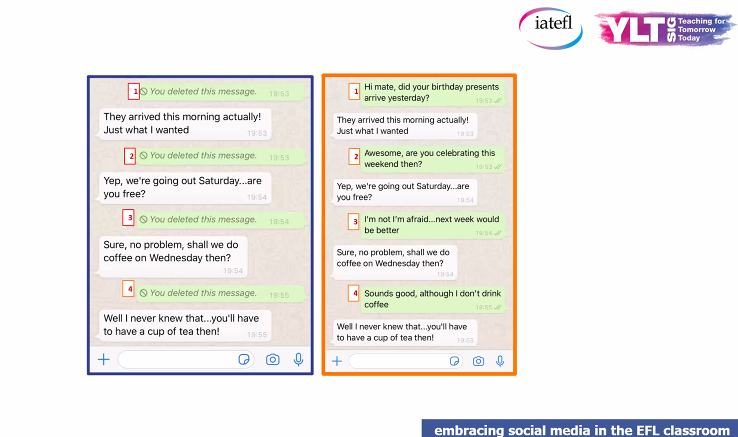How can we use social media and other apps to motivate, engage and interest 21st-century learners? At this year’s YLTSIG Conference, Greg Wagstaff shared some tried and tested methods for incorporating technology in the EFL classroom.
Greg kicked off his talk by stating that the average person spends 144 minutes per day on social media, which comes down to more than two hours on apps like Twitter, Instagram or LinkedIn. Thus, social media – and technology in general – are very much part of our everyday lives. But do our classrooms reflect this reality, and why would it matter anyway?
Tasks in real-world context
Teaching usually focuses on language acquisition, not the context in which what is learned will be used. This separation has a downside: sometimes it isn’t fathomable to students in what way the lesson will help them; and if it is, learning may still feel “clinical” and lack a sense of genuineness. As a result, learners may not be as engaged and interested as they could be.
That’s why providing the missing link between the classroom and the real world can be a game changer. Once students learn to apply something that benefits them on a daily basis, learning will feel much more meaningful and intriguing.
Greg suggested three technology-based activities that can help create a realistic atmosphere:
- Sending emails: Instead of practicing writing emails on paper (or in a Word document), learners can simply write real ones and send them to the teacher, themselves, fellow learners or other contacts.
- Making phone calls: Instead of doing a standard role play, let students call you/each other on the phone and practice speaking.
- Being active on social media: Learners can create posts or write comments using their own accounts. As an alternative, they can create realistic simulations of social media posts on zeoob.com.
Seeing the immediate real-world benefit of what they do in class is guaranteed to get your learners on board and boost motivation.
Using language from real-world contexts
Besides giving tasks that feel real to your students, you can breathe life into practicing grammar and vocabulary by using “digital realia” as discussion starters. Greg recommended the following:
- Voice notes: These are great for practicing reported speech. Just play the note to your learners and let them repeat the message in RS. Youtube works for this, too.
- Twitter posts: They can be used to practice the past tense (“When did (person) post tweet X, and what was it about?”).
- Photo caches: You can let students share their photo caches to talk about their experiences, wishes for the future and regrets.
Connecting with the real world through authentic materials will make any session of yours much more relatable and interesting.
Resources through connectivity
When we communicate via social media and messenger apps, we automatically create resources. Greg showed us how to use WhatsApp chats as lesson materials. He gave us a screenshot of a conversation between two people, with one side being blanked out. We then were to guess and fill in the missing lines.
The result was a gap-fill exercise that felt realistic and engaging. The good thing about this kind of resource is that you can easily make your own and even have your students create resources themselves.
Self-assessment
Other than for exercises, technology can be used for self-reflection. The recording function on cell phones is a great way to facilitate self- and peer assessment. It gives students a direct impression of their skill level. Having learners evaluate their pronunciation can be part of the lesson.
Just remember that perfectionism is a trap – it’s not about sounding like a native speaker with perfect RP. Learners can ask themselves:
- Were they intelligible and fluid?
- What was good?
- What can be improved?
If your learners are interested, video recording can help them evaluate themselves even better. Greg suggests making space for single, pair or group work, to make sure your learners are undisturbed while recording themselves.
English outside the classroom
There are some simple things that can help students stay on track outside the classroom, and they are just a click away. Greg encourages his learners to change their phone settings to English, to
follow English channels (such as the BBC) on Youtube or Twitter or to start their own channel in English. Modern technology makes all of this as easy as can be.
Modern communication is…different
Keep in mind that technology is constantly influencing modern communication. 20 years ago, mobile phones and text messages were considered advanced technology. Nowadays, emojis, video calls, voice messages and text speak (i.e. acronyms such as IMHO, FYI, etc.) are part of everyday communication.
This also means that, depending on the age group you teach, your learners might know more about tech than you do. Greg’s advice on this is to embrace learning from your students – as an English teacher, you don’t have to be a tech expert as well, and they will enjoy sharing their knowledge with you.
Use technology wisely
Especially when teaching younger learners, using digital tools like smartphones is a double-edged sword. As a teacher, you want to reap the benefits of technology while avoiding the pitfalls: overuse and distraction. So before you start incorporating technology in your teaching, you might want to have a conversation about it.
You can tell your students that you’ll be happy to use technology for specific purposes, but that you don’t condone the excessive use of smartphones and tablets, especially when not related to your lessons. (Again, this probably depends on who you teach, but can be a sensible one-off statement, no matter the group of learners).
Final thoughts on using social media in the EFL classroom
Greg’s interactive and fun presentation made it easy to follow. It gave us a glimpse of what an interactive, social-media-infused lesson could look like. As long as we manage to stay on the ‘constructive’ side of things and use it wisely, technology is a great way to make lessons more vivid, realistic and engaging.
***

Sandra is ELTABB's Chair and the current editor of the ELTABB journal. She holds an MA in English and is passionate about brain-friendly language learning and teaching. Likes Shakespeare and Venetian lute music.









Worth praising and worth adopting suggestions.One certainly can learn English quickly and efficiently too. Congratulation for such a good read.
Thanks Surendra! I’m happy you found it useful. 🙂